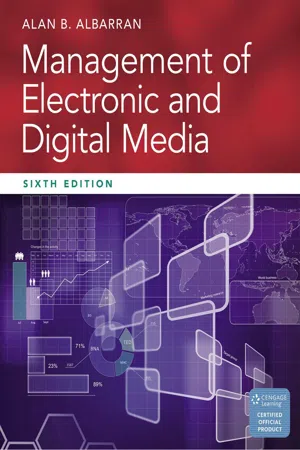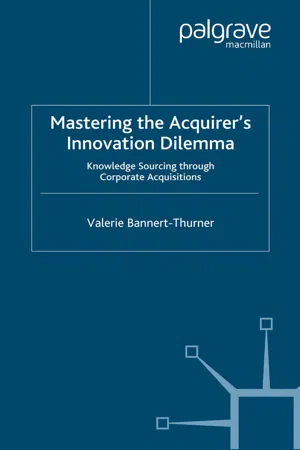Technology & Engineering
Financial Management
Financial management refers to the process of planning, organizing, controlling, and monitoring financial resources to achieve organizational goals. It involves making financial decisions, managing budgets, and analyzing financial data to ensure the efficient use of resources. Effective financial management is essential for the success of any organization.
Written by Perlego with AI-assistance
Related key terms
1 of 5
4 Key excerpts on "Financial Management"
- eBook - PDF
- Alan Albarran(Author)
- 2016(Publication Date)
- Cengage Learning EMEA(Publisher)
All Rights Reserved. May not be copied, scanned, or duplicated, in whole or in part. Due to electronic rights, some third party content may be suppressed from the eBook and/or eChapter(s). Editorial review has deemed that any suppressed content does not materially affect the overall learning experience. Cengage Learning reserves the right to remove additional content at any time if subsequent rights restrictions require it. profit or loss. Those preparing for a career in management or entre-preneurship — or any business — must understand the role of Financial Management. What Is Financial Management? To properly manage the finances of an organization, managers use Financial Management , which involves systematic planning, monitor-ing, and control. Though planning involves many areas, it mainly con-cerns developing budgets based on revenue history and expense projections. In planning, one also plans for new personnel positions and establishes timelines for the upgrading and replacement of expen-sive items, such as capital equipment, vehicles, and technology. Finan-cial planning is always conducted in conjunction with the overall strategic plan established by the organization. Monitoring takes place through managerial review of financial state-ments and other reports that measure the efficiency of an organization. Later in the chapter you will learn more about financial statements — such as income statements and balance sheets — that are commonly used in busi-ness. Managers need to be familiar with the content of financial statements and how to interpret and evaluate them. Control can take many forms, from authorizing purchases to establishing internal policies and procedures. Control of fiscal policy helps eliminate ambiguity in an organization ’ s financial matters. Exec-utive managers work together with middle managers to administer individual budgets and evaluate performance. - Barry Benator, Albert Thumann(Authors)
- 2020(Publication Date)
- River Publishers(Publisher)
Chapter 5 Technical, Schedule, Financial Management Barry Benator T he essence of effective project management is to manage the technical, schedule and financial elements of a project to a successful conclusion, resulting in a profitable project for your firm and a satisfied customer who wants to do business with you and your company in the future. As an engineering or construction project manager, this is what you are expected to do. This chapter provides specific guidance on how to effectively accomplish these tasks. If you follow this guidance, you will en- hance your results in these areas. But it is important to understand that effective technical, schedule and Financial Management is not a one time event. As project manager, you must continually keep your hand on the rudder to ensure the project is headed in the right direction. Specific practices for effective technical, schedule and Financial Management are presented in the following sections of this chapter. THE ROLE OF COMMUNICATIONS The first step in effective technical, schedule and Financial Management is for you, the project manager, to continually em- phasize the importance of meeting the customer’s and your firm’s technical, schedule and Financial Management expectations. Say- 53 54 Project Management and Leadership Skills ing it one time is not enough. You don’t want to be a broken record, but you do want to reinforce the importance of meeting technical, schedule and financial targets at every reasonable op- portunity. You can and should initiate communications about your ex- pectations at your first project team meeting. Typically this meet- ing would be held after you have been designated as the project manager and one or more of your project team members have been assigned, but it can be held anytime. When I use the expres- sion project team, I am referring to both internal and external team members (members of your firm, contractors, consultants, ven- dors, etc.).- eBook - PDF
Mastering the Acquirer's Innovation Dilemma
Knowledge Sourcing Through Corporate Acquisitions
- Valerie Bannert-Thurner(Author)
- 2005(Publication Date)
- Palgrave Macmillan(Publisher)
Thus these strategic decisions on the path to achieving the technology strategic goal are the driving forces of technology marketing. Technology marketing is concerned with technology acquisition and external exploitation or deployment. Thus such topics as IP management Technology, Innovation and their Management 25 Figure 2.7 Technology assessment methods depending on degree of uncertainty Qualitative Quantitative Degree of associated uncertainty Application context Company context No context Discounted cash flow methods Functional ideality Core competence model Real option model Scoring & ranking methods Portfolio Cost-based methods Rules of thumb Relative/ market valuation TRIZ Scenarios and licensing, technology spin-outs, joint ventures, and also technology- intensive acquisitions are subject to technology marketing. It can be summarized that strategic technology management is mainly concerned with the formulation and implementation of technology strategy. In doing so, different tasks such as technology planning, assessment and controlling as well as the continuous tasks of technology intelligence and marketing support the strategic processes. These management concepts to master an efficient resource deployment will be integrated within the strategic acquisition and integration management to foster the acquirer’s mastery of the innovation dilemma. 2.3 Innovation Management The previous section on Technology Management has introduced concepts to support technology-based value creation from resource deployment. Innovation as a subsequent step is the utilization of the diligently selected and assessed and efficiently deployed resource base to create value through innovations. Thus the main notions of, and concepts to manage, innovations have to be outlined and incorporated into the technology-based strategic acquisition and integration management. Innovation management also comprises innovation strategy formulation as well as implementation. - eBook - PDF
- Maxime Sottini(Author)
- 2017(Publication Date)
- Van Haren Publishing(Publisher)
Use is for Single Users only via a VHP Approved License. For information and printed versions please see www.vanharen.net Description of Financial Management activities 65 4.5 Relationships with other functions, processes and practices IT Financial Management has a set of relationships with other important processes and practices of IT service management. Some aspects of these relationships have been explored when examining each activity of IT Financial Management in the previous sections of this chapter. We will now examine them in more detail, from the viewpoint of the external interfaced processes and practices. 4.5.1 Demand management Demand management is a critical aspect of service management and is linked to IT Financial Management. This happens because a tight coupling exists between demand and capacity (see Figure 4.16), which means that peaks of requests cannot always be managed without impacts on service quality. Tariffs generally affect demand, as higher costs should reduce demand. This effect may be used to control demand by means of techniques such as differential charging, which encourages customers to use services at less busy times. Demand management should pass information back to IT Financial Management about the results achieved when such techniques and, more generally, control of demand patterns is achieved by making use of IT Financial Management. 4.5.2 Risk management Risk management, according to the definition provided by the UK Office of Government Commerce’s Management of Risk (M_o_R) methodology, is ’the task of ensuring that organization makes cost effective use of risk processes’. Risk management covers a wide range of topics, including business continuity management, security, program/project management and operational service management, which covers IT services too. Risk management uses many techniques to identify, evaluate, plan, control and monitor risks.
Index pages curate the most relevant extracts from our library of academic textbooks. They’ve been created using an in-house natural language model (NLM), each adding context and meaning to key research topics.



